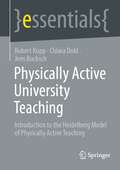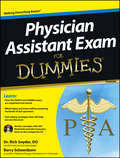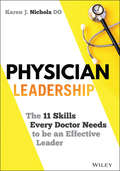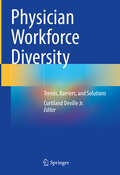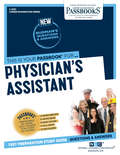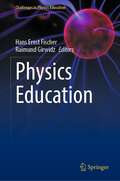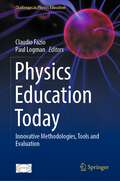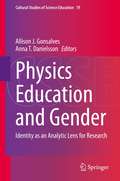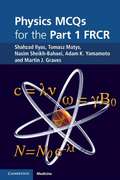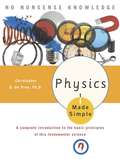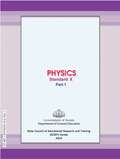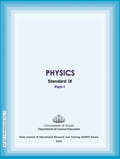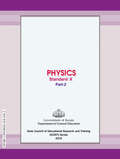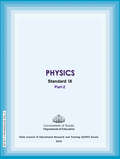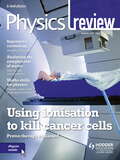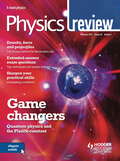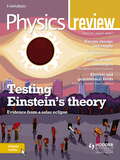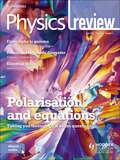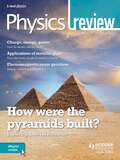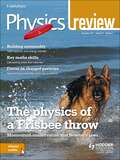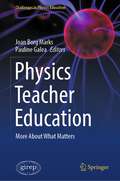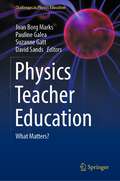- Table View
- List View
Physical: Next Generation Middle Grade Science 2019 (Grade 8)
by Prentice-Hall Staff*This textbook has been transcribed in UEB, formatted according to Braille textbook formats, proofread and corrected. <P><P>
Physically Active University Teaching: Introduction to the Heidelberg Model of Physically Active Teaching (essentials)
by Robert Rupp Chiara Dold Jens BuckschIn this essential, the authors present an innovative teaching-learning concept that uses the potential of movement-activating approaches to make university teaching more motivating, more efficient for learning and more conducive to health. Based on current findings in health, work and learning research, the Heidelberg Model of Moving Teaching presents a proven approach that combines university teaching-learning processes with light (micro) movement - such as standing up or walking around - in a way that saves learning time and is close to the classroom. This gives students the opportunity to abandon the rigid sitting posture during teaching and to actively engage with the subject matter (through movement). The essential contains practice-stimulating recommendations and concrete examples of implementation for a moving design of university teaching.
Physician Assistant Exam For Dummies
by Barry Schoenborn Richard SnyderThe easy way to score high on the PANCE and PANRE Physician Assistant Exam For Dummies, Premier Edition offers test-taking strategies for passing both the Physician Assistant National Certifying Exam (PANCE) and the Physician Assistant National Recertifying Exam (PANRE). It also offers information on becoming a certified Physician Assistant (PA) and the potential positions within this in-demand career field. Physician Assistant Exam For Dummies provides you with the information you need to ace this demanding exam and begin your career in one of the fastest growing segments of healthcare. Offers an overview of test organization and scoring Content review with practice tests for each section of the exam Five full-length practice tests An interactive CD includes 3 of the 5 practice tests?including one PANRE?a digital slide slow featuring 20 plus images,and more than 300 flashcards covering the 13 official categories of the PANCE and PANRE Physician Assistant Exam For Dummies, Premier Edition serves as a valuable, must-have resource, desk reference, and study guide for those preparing for either the PANCE or the PANRE. CD-ROM/DVD and other supplementary materials are not included as part of the e-book file, but are available for download after purchase.
Physician Leadership: The 11 Skills Every Doctor Needs to be an Effective Leader
by Karen J. NicholsYou know how to practice medicine. Now learn how to lead with this insightful resource from one of medicine’s most accomplished leaders. In Physician Leadership, renowned medical leader Dr. Karen J. Nichols delivers a concise guide for busy physicians doing their best to successfully lead people and organizations. The book covers foundational leadership essentials that every physician needs to master to transform themselves from a highly motivated novice leader into an effective, skilled, and productive leader. Each chapter offers readers a summary of the crucial points found within, sample questions, exercises, and a bibliography of the relevant academic literature for further study. Ideal for doctors who don’t have the time to peruse an unwieldy collection of the latest research and thought on organizational leadership, or to take a multi-day course on effective leadership, Physician Leadership distills the author’s extensive research and personal experience into a short and practical handbook. Physician Leadership provides actionable, real-world advice for practicing and aspiring physicians: A thorough introduction to personal approach and style when interacting with patients, managers, boards, and committees An exploration of how to employ the principles of effective communication to achieve desired results and practical techniques for implementing those principles Practical discussions of the role that perspectives play in shaping an organization’s culture and how those perspectives affect leadership efficacy In-depth examinations of approaches to decision-making that get buy-in from others and achieve results Perfect for doctors stepping into a leadership role for the first time, Physician Leadership also belongs on the bookshelves of experienced physician leaders seeking to improve their leadership abilities and improve the results of their organizations.
Physician Workforce Diversity: Trends, Barriers, and Solutions
by Curtiland DevilleThis book offers a comprehensive summary of the current and historical trends in physician workforce diversity by residency training specialty and demographic identity group. This book serves as a one-stop source for physician workforce diversity from the perspective of training specialties, summarizing trends over time, historical barriers, and specialty specific interventions and solutions. Chapters provide a necessary foundational resource for medical educators seeking to enhance diversity, equity, and inclusion (DEI) in their programs and programming. It similarly supports health system and organizational leaders in understanding the current and historical landscape of DEI across medical specialties and demographic groups to inform their interventions and initiatives in an evidence-based manner. The book is divided into two sections: training specialties and demographic identity groups. In the first section, DEI within several of the largest medical residency training specialties is explored. In the second section, the representation trends of various demographic identity groups, including women and individuals from racial and ethnic minority groups, and deaf and disabled individuals, are discussed, as well as barriers and solutions to improving representation, equity, and inclusion. Each chapter will follow the same format: Relevant specialty- or demographic-specific literature is reviewed, discussing the rationale for workforce diversity and inclusion in that specialty or demographic identity group. Current data by race, ethnicity, sex, and other available demographics is discussed for various trainee and practicing physician categories across the training and professional continuum, such as practicing physicians, academic faculty, graduate medical education residents and fellows, residency applicants, and medical school graduates. Historical demographic trends are assessed over time. This is followed by a thorough discussion of specialty or demographic-specific strengths and weaknesses to DEI and related barriers, impediments, and interventions and solutions. This is an ideal guide for medical educators, department chairs in academia and private/community practice, health system leaders, healthcare organization board members and executive leaders, diversity thought leaders, search committees, and medical students and trainees, especially during their specialty selection process.
Physician's Assistant: Passbooks Study Guide (Career Examination Series #C-2557)
by National Learning CorporationThe Physician’s Assistant Passbook® prepares you for your test by allowing you to take practice exams in the subjects you need to study. It provides hundreds of questions and answers in the areas that will likely be covered on your upcoming exam, including but not limited to; Obtaining detailed case histories of patients; Recording detailed narrative case summaries; Ability to follow instruction; Assisting supervising physician in delivering service to patients; and more.
Physics Education (Challenges in Physics Education)
by Raimund Girwidz Hans Ernst FischerThis book offers a comprehensive overview of the theoretical background and practice of physics teaching and learning and assists in the integration of highly interesting topics into physics lessons. Researchers in the field, including experienced educators, discuss basic theories, the methods and some contents of physics teaching and learning, highlighting new and traditional perspectives on physics instruction. A major aim is to explain how physics can be taught and learned effectively and in a manner enjoyable for both the teacher and the student. Close attention is paid to aspects such as teacher competences and requirements, lesson structure, and the use of experiments in physics lessons. The roles of mathematical and physical modeling, multiple representations, instructional explanations, and digital media in physics teaching are all examined. Quantitative and qualitative research on science education in schools is discussed, as quality assessment of physics instruction. The book is of great value to researchers involved in the teaching and learning of physics, to those training physics teachers, and to pre-service and practising physics teachers.
Physics Education Today: Innovative Methodologies, Tools and Evaluation (Challenges in Physics Education)
by Claudio Fazio Paul LogmanThis book provides an in-depth exploration of the latest developments in physics education. It presents a comprehensive look into cutting-edge research and ideas used to improve physics education around the world. Topics covered include (but are not limited to) the use of problem-based learning, the design and evaluation of teaching materials, and the use of digital technologies. This book is essential for anyone looking to stay up-to-date on the latest educational innovations and to develop an understanding of effective teaching approaches. It is aimed at researchers, teachers, students, policymakers, and educational leaders in the field of physics education.
Physics Education and Gender: Identity as an Analytic Lens for Research (Cultural Studies of Science Education #19)
by Allison J. Gonsalves Anna T. DanielssonThis Edited Volume engages with concepts of gender and identity as they are mobilized in research to understand the experiences of learners, teachers and practitioners of physics. The focus of this collection is on extending theoretical understandings of identity as a means to explore the construction of gender in physics education research. This collection expands an understanding of gendered participation in physics from a binary gender deficit model to a more complex understanding of gender as performative and intersectional with other social locations (e.g., race, class, LGBT status, ability, etc). This volume contributes to a growing scholarship using sociocultural frameworks to understand learning and participation in physics, and that seeks to challenge dominant understandings of who does physics and what counts as physics competence. Studying gender in physics education research from a perspective of identity and identity construction allows us to understand participation in physics cultures in new ways. We are able to see how identities shape and are shaped by inclusion and exclusion in physics practices, discourses that dominate physics cultures, and actions that maintain or challenge structures of dominance and subordination in physics education. The chapters offered in this book focus on understanding identity and its usefulness in various contexts with various learner or practitioner populations. This scholarship collectively presents us with a broad picture of the complexity inherent in doing physics and doing gender.
Physics MCQs for the Part 1 FRCR
by Tomasz Matys Nasim Sheikh-Bahaei Adam K. Yamamoto Shahzad Ilyas Martin John GravesPhysics MCQs for the Part 1 FRCR is a comprehensive and practical revision tool for the new format Part 1 FRCR examination, covering the complete physics curriculum. Key features: * Contains 300 questions that reflect the style and difficulty of the real exam * Covers basic physics, radiation legislation and all the imaging modalities included in the Royal College of Radiologists training curriculum and new FRCR examination * Includes new exam topics such as MRI and ultrasound imaging * Answers are accompanied by clear, detailed explanations giving candidates in-depth understanding of the topic * Much of the question material is based on the Radiology-Integrated Training Initiative (RITI), as recommended by the Royal College of Radiologists A must-have revision resource for all Part 1 FRCR candidates, Physics MCQs for the Part 1 FRCR is written by a team of specialist registrars who have recently successfully passed the Part 1 FRCR exam and a renowned medical physicist.
Physics MCQs for the Part 1 FRCR
by Tomasz Matys Nasim Sheikh-Bahaei Adam K. Yamamoto Shahzad Ilyas Martin J. Graves Shahzad Ilyas Tomasz Matys Nasim Sheikh-Bahaei Adam K. YamamotoPhysics MCQs for the Part 1 FRCR is a comprehensive and practical revision tool for the new format Part 1 FRCR examination, covering the complete physics curriculum. Key features: • Contains 300 questions that reflect the style and difficulty of the real exam • Covers basic physics, radiation legislation and all the imaging modalities included in the Royal College of Radiologists training curriculum and new FRCR examination • Includes new exam topics such as MRI and ultrasound imaging • Answers are accompanied by clear, detailed explanations giving candidates in-depth understanding of the topic • Much of the question material is based on the Radiology-Integrated Training Initiative (RITI), as recommended by the Royal College of Radiologists A must-have revision resource for all Part 1 FRCR candidates, Physics MCQs for the Part 1 FRCR is written by a team of specialist registrars who have recently successfully passed the Part 1 FRCR exam and a renowned medical physicist.
Physics Made Simple: A Complete Introduction to the Basic Principles of This Fundamental Science (Made Simple)
by Christopher Gordon De PreeUnderstand the rules that make the universe run. Understanding the laws of physics is essential for all scientific studies, but many students are intimidated by their complexities. This completely revised and updated book makes it easy to understand the most important principles. From the physics of the everyday world to the theory of relativity, PHYSICS MADE SIMPLE covers it all. Each chapter is introduced by anecdotes that directly apply the concepts to contemporary life and ends with practice problems--with complete solutions--to reinforce the concepts. Humorous illustrations and stories complete the text, making it not only easy but fun to learn this important science. Topics covered include: * force * motion * energy * waves * electricity and magnetism * the atom * quantum physics * relativity* spectroscopy * particle physics.
Physics Part 1 class 10 - S.C.E.R.T. - Kerala Board
by State Council of Educational Research TrainingPhysics Part 1 textbook for 10th standard from State Council of Educational Research and Training (S.C.E.R.T.) Kerala in English.
Physics Part 1 class 9 - S.C.E.R.T. - Kerala Board
by State Council of Educational Research TrainingPhysics Part 1 text book for 9th standard from State Council of Educational Research and Training (S.C.E.R.T.) Kerala in English.
Physics Part 2 class 10 - S.C.E.R.T. - Kerala Board
by State Council of Educational Research TrainingPhysics Part 2 textbook for 10th standard from State Council of Educational Research and Training (S.C.E.R.T.) Kerala in English.
Physics Part 2 class 9 - S.C.E.R.T. - Kerala Board
by State Council of Educational Research TrainingPhysics Part 2 text book for 9th standard from State Council of Educational Research and Training (S.C.E.R.T.) Kerala in English.
Physics Review Magazine Volume 28, 2018/19 Issue 1
by Philip Allan MagazinesThis A-level physics magazine provides up-to-date articles specially written for students to help them gain their highest grade. Exam topics are clearly signposted in articles and there are specific features on maths skills and on approaching exam questions. Physics Review aims to help students with depth of knowledge, revision and avoiding common mistakes in the exam.ContentsProton therapy The swinging ponytail Who were they? Robert R. Wilson, 1914-2000 Exam talkback: Analysing the complexities of waves Mathskit: Angles, units and approximations At a glance: Particle tracks Supernova cosmology Crossword: Clues Physics online: Electricity supply Crossword: Solution and notes Working with physics: Helicopter pilot Tycho's supernova
Physics Review Magazine Volume 28, 2018/19 Issue 2
by Philip Allan MagazinesContentsBouncing bombs: the physics behind the Dambusters raidSkillset: OscillationsMathskit: Simple harmonic motionWho were they? Hedy LamarrCrossword: CluesAt a glance: GPSExam talkback: Radioactive decay and nuclear radiationThe Nobel prize in 1918: quantum physicsPhysics online: The new Elizabethan ageLuis Alvarez: a versatile physicistCrossword: Curves, Chaucer and computing: solution and notesPhysics and war
Physics Review Magazine Volume 28, 2018/19 Issue 3
by Philip Allan MagazinesCONTENTSWhere is the North Pole?Crossword: CluesWill electric cars break the National Grid?Mathskit: Forces, vectors and anglesWho were they? Arthur Eddington, 1882-1944At a glance: Solar eclipseExam talkback: Electric and gravitational fieldsSkillset: Magnetic forces on a current-carrying wirePhysics online: The periodic tableHow loud is that?Crossword: Humidity, eclipses and early scientists: solution and notesMicromotors
Physics Review Magazine Volume 28, 2018/19 Issue 4
by Philip Allan MagazinesViking navigationIsotopes of hydrogenPhysics online: The race to the Moon: 50 years onSkillset: Measuring the Planck constantWho are they? Donna StricklandAt a glance: Polarised lightExam talkback: Polarising filtersCrossword: CluesRadiation: not so simpleMathskit: Forces and free-body diagramsCrossword: Light and heat: solution and notesIndex to Volume 28Cherenkov radiation
Physics Review Magazine Volume 29, 2019/20 Issue 1
by Hodder Education MagazinesElectric vehicles: how do they work?Skillset: Investigating the internal resistance of a cellBuilding the pyramidsPhysics online: Medical imagingAt a glance: Mapping Earth's gravityBrownian motion revisitedMathskit: Areas, volumes and unitsCrossword: CluesExam talkback: Electromagnetic induction and energy transferWho were they? Glenn T. Seaborg (1912-99)Crossword: Telescopes and elements: solution and notesMetallic glasses: properties and applicationsMaking elements
Physics Review Magazine Volume 29, 2019/20 Issue 2
by Hodder Education MagazinesSustainable buildingWhat use are theories?Rutherford's nuclear atom revisitedWho were they? Dmitri Mendeleev, 1834-1907Crossword: CluesPhysics online: RadioactivityAt a glance: Air resistanceFrisbee physics: Peter MainMathskit: Calculating areas and volumesExam talkback: Forces on charged particlesThe Nobel prize in 1919: the Stark effectCrossword: Stability, sliding and stars: solution and notesLeonardo da Vinci
Physics Teacher Education: More About What Matters (Challenges in Physics Education)
by Joan Borg Marks Pauline GaleaThis book focuses on some important aspects of Physics Education: the role of metaphors in Physics teaching and learning, the connections between Physics and Mathematics, the interaction of young children with Physics at the primary level, and recent developments in teacher education in the USA. Contributors present their research related to: • Preparing teachers for TPACK (technological, pedagogical, and content knowledge) and laboratory work. • Developing and evaluating teacher PCK (pedagogical content knowledge) in Quantum Mechanics. • In-service Physics teacher education for early childhood and primary levels. • Pre-service Physics teacher education at all levels. • In-service Physics teacher professional learning for second and higher-level education. Chapters in this book inevitably look into how Physics teacher education is organized in different countries. Suggestions are offered for possible ways of supporting Physics teachers’ learning. An emphasis is made on the much-needed measurements of the effectiveness of different teaching strategies that improve teaching for learning.All this should help professionals, researchers, and pre-service, as well as in-service teachers to get acquainted with the most recent research contributions in the field.
Physics Teacher Education: What Matters? (Challenges in Physics Education)
by David Sands Joan Borg Marks Pauline Galea Suzanne GattThis book presents the most up-to-date research contributions focusing on progress in the field of physics education. It provides researches and results that are based on the most relevant matters in physics teacher education and how these matters can be improved for the satisfaction of both teachers and learners. The work is the by-product of the collaboration between GIREP (the International Research Group on Physics Teaching) and the University of Malta. The contributing authors present close examinations of the following topics: ICT and multimedia in teacher education; experiments and laboratory work in teacher education; the role of quantum mechanics in teaching and learning physics; formal, non-formal and informal aspects of physics education at the primary level; strategies for pre-service physics teacher education at all levels; and in-service teacher professional learning strategies. The editors hope that many different stakeholders within scientific academia will find something of value in this compilation of the current most advanced ideas in physics education.

